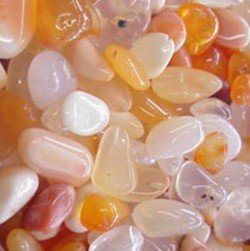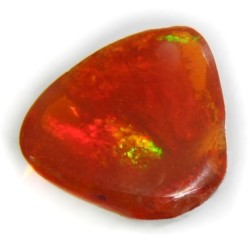The term fire opal is used for color varieties of noble (opalescent) or common (not opalescent) opal, that cover the entire color range from yellow-orange to orange-red, red to deep redish brown. Ferreous solutions rich in silicon dioxide are responsible for the formation of these opal varieties.

Fig. 1: Good quality fire opal has an intensely orange-red color. Superior qualities also show an opalescence that ennobles them to a precious opal.
Photo: K. Sieber, www.makrogalerie.de

Fig. 2: Light-colored rhyolite from Mexico. The left peace is without fire opal, the right one with fire opal and other opal varieties
Photo: K. Sieber, www.makrogalerie.de
Fire opal preferably forms in cracks and cavities of rhyolitic rocks rich in quartz. The most important deposits are located in Mexico. They occur in an "opal belt" running east to west from the city of Pachuca to Guadalajara.
This GemRock was already known by the Mayas and Aztecs, but with the invasion of the Spanish conquerors, the locations of the deposits were forgotten. It was not until 1835 that the treasures hidden in the Mexican highlands were rediscovered and systematically mined. Today, the fire opal is considered the national stone of the Central American state.
Apart from the exceptionally large fire opals found in Campos Borges in the southern Brazilian state of Rio Grande do Sul, all other sites on earth, e.g., in Honduras, Guatemala, USA, Canada, Australia, Ethiopia, Turkey and Indonesia are of no economic importance.
Not all fire opal is the same. Four factors contribute to the quality evaluation of fire opals:
1. Color
Stones that are too pale or almost black in color are not accepted as fire opal. It is not unusual that fire opal occur within narrow domains with »Yelly Opal«, »Milk Opal« and other color varieties. That's why you have to pay attention when buying a lot of fire opal: colorless, pale yellow and white specimens are not fire opals and of limited commercial value.
2. Transparency
The more transparent a stone the more valuable it is. Dull stones are very common and more or less accepted, but opaque stones without opalescence are miserable. Australian prospectors call them "potch".
3. Opalescence
You have to differentiate between non-opalescent fire opals and high-quality opalescent fire opals. Distinctive for good quality noble opals is an intensive color and a vivid play of colors. The more colors of the spectrum in the play of colors is visible and the better the transparency, the higher the value of the stone.
4. Durability
When mined, some rough stones are covered with a chalky, white weathered crust - a sign of an aging process due to loss of water. The susceptibility to this dehydration process, which makes the stones cloudy and cracky, is usually visible within the first year after mining. A rule of thumb is: the drier the deposit site, the more durable the opals.
Bodycolor, transparency, play of colors and susceptibility to cracking are the price-determining criteria for fire opals. The most desired stones are intensely red-orange with strong opalescence.
Cheap Mixtures

Fig. 3: Typical "fire opal" mix from a tumbled stone assortment. Even though all pieces originate from the same mine, only few stones are actually fire opal. (Photo: Archive EPI)
"Run of Mine"
In the price segment of inexpensive tumbled stones it is common practice that the whole run of mine is processed. This is why colorless, white, yellow to brown ordinary opal (non-opalescent) and white, orange-red to red-brown noble opal (opalescent) are mixed together in one lot (Fig. 3). For a Retailer it goes without saying to either separate such mixed assortments neatly or to declare them as "partly fire opal".
"Matrix Opal"
In the same way fragments of rhyolite rock with small colorless, white, orange or brown-red opal (Fig. 2) should not be declared as "Fire Opals". In Mexico they are called "Canteras", which means quarry stone. In Europe they are traded as "fire opal in matrix". As the bedrock consists of a rhyolitic volcanic rock, their correct name is: Opal in Rhyolite.
Author: Dipl.-Min. B. Bruder
© INSTITUT FÜR EDELSTEIN PRÜFUNG (EPI)




